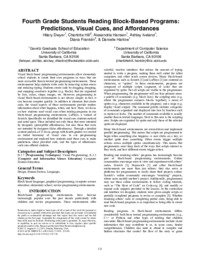Fourth Grade Students Reading Block-Based ProgramsPredictions, Visual Cues, and Affordances
Hilary A. Dwyer, Charlotte Hill, Alexandria K. Hansen, Ashley Iveland, Diana Franklin, Danielle Harlow
Publikationsdatum:
Zu finden in: ICER 2015 (Seite 111 bis 119), 2015
|
 |
 Diese Seite wurde seit 2 Jahren inhaltlich nicht mehr aktualisiert.
Unter Umständen ist sie nicht mehr aktuell.
Diese Seite wurde seit 2 Jahren inhaltlich nicht mehr aktualisiert.
Unter Umständen ist sie nicht mehr aktuell.
 Zusammenfassungen
Zusammenfassungen
Visual block-based programming environments allow elementary school students to create their own programs in ways that are more accessible than in textual programming environments. These environments help students write code by removing syntax errors and reducing typing. Students create code by dragging, dropping, and snapping constructs together (e.g. blocks) that are organized by lists, colors, shape, images, etc. However, programming in visual block-based environments is not always simple; in fact, it can become complex quickly. In addition to elements that create code, the visual aspects of these environments provide readers information about what happens, when, and how. Here, we focus on how students used visual cues when reading programs in our block-based programming environment, LaPlaya, a variant of Scratch. Specifically we identified the visual cues students noticed and acted upon. These included not only those that were intended by designers (perceptible affordances), but also those that were not intended by designers (false affordances). Through a detailed content analysis of 13 focus groups with fourth graders we created an initial taxonomy of visual cues in our programming environment and explored how students used these cues to make predictions about provided code, and the types of affordances such cues offered students.
 Dieses Konferenz-Paper erwähnt ...
Dieses Konferenz-Paper erwähnt ...
 Dieses Konferenz-Paper erwähnt vermutlich nicht ...
Dieses Konferenz-Paper erwähnt vermutlich nicht ... 
 Nicht erwähnte Begriffe | AgentCubes, Kinder, LehrerIn, Semantik, Unterricht |
 Tagcloud
Tagcloud
 Zitationsgraph
Zitationsgraph
 Zitationsgraph (Beta-Test mit vis.js)
Zitationsgraph (Beta-Test mit vis.js)
 2 Erwähnungen
2 Erwähnungen 
- Informatische Bildung zum Verstehen und Gestalten der digitalen Welt - 17. GI-Fachtagung Informatik und Schule (Ira Diethelm) (2017)

- Informatikunterricht zwischen Aktualität und Zeitlosigkeit - 20. GI-Fachtagung Informatik und Schule (Lutz Hellmig, Martin Hennecke) (2023)


- Programmierfeedback für Kinder: Text oder Bild? - Eine Mixed-Methods-Studie in einem Roboter-Kurs (Luisa Greifenstein, Ute Heuer, Gordon Fraser) (2023)


- Programmierfeedback für Kinder: Text oder Bild? - Eine Mixed-Methods-Studie in einem Roboter-Kurs (Luisa Greifenstein, Ute Heuer, Gordon Fraser) (2023)
 Anderswo finden
Anderswo finden
 Volltext dieses Dokuments
Volltext dieses Dokuments
 |  Fourth Grade Students Reading Block-Based Programs: Fulltext at the ACM Digital Library ( Fourth Grade Students Reading Block-Based Programs: Fulltext at the ACM Digital Library ( : :  , 4597 kByte; , 4597 kByte;  : :  2020-11-28) 2020-11-28) |
 Anderswo suchen
Anderswo suchen 
 Beat und dieses Konferenz-Paper
Beat und dieses Konferenz-Paper
Beat hat Dieses Konferenz-Paper während seiner Zeit am Institut für Medien und Schule (IMS) ins Biblionetz aufgenommen. Beat besitzt kein physisches, aber ein digitales Exemplar. Eine digitale Version ist auf dem Internet verfügbar (s.o.). Es gibt bisher nur wenige Objekte im Biblionetz, die dieses Werk zitieren.









 Primarschule (1-6) / Grundschule (1-4)
Primarschule (1-6) / Grundschule (1-4) Programmieren
Programmieren Schule
Schule Scratch
Scratch






 Biblionetz-History
Biblionetz-History